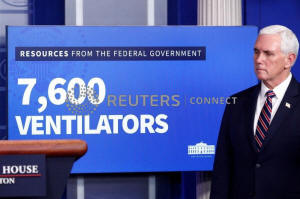U.S. revs up ventilator production
for coronavirus patients as need wanes
 Send a link to a friend
Send a link to a friend
 [April 21, 2020]
By David Shepardson and Carl O'Donnell [April 21, 2020]
By David Shepardson and Carl O'Donnell
WASHINGTON/NEW YORK (Reuters) - The
Trump administration, under pressure to do more to ramp up
coronavirus testing in order to safely reopen the battered U.S.
economy, is highlighting this week a $2.9 billion program to build
187,000 ventilators this year.
The administration's ventilator surge is accelerating as medical
experts are forecasting the need for the devices - used to help
severely ill COVID-19 patients breathe - will fall. Many of the
ventilators will now be sent to other countries in need, the
administration says.
Vice President Mike Pence on Tuesday plans to visit a General
Electric Co <GE.N> facility in Madison, Wisconsin, where they
assemble ventilators, the company and his office confirmed.
On Monday, U.S. President Donald Trump taunted critics of his
administration's coronavirus response, tweeting: "Last month all you
heard from the Radical Left, Do Nothing Democrats was, “Ventilators,
Ventilators, Ventilators.” They screamed it loud & clear, & thought
they had us cold, even though it was the State's task. But everyone
got their V’s, with many to spare."

Ventilators became a symbol in March of the lack of preparedness in
the U.S. medical system for the surge in patients suffering from
COVID-19, the disease caused by the virus that attacks the lungs.
New York Governor Andrew Cuomo, whose state has been the epicenter
of the U.S. outbreak with more than 240,000 cases, had said his
state alone could need as many as 30,000 ventilators.
On March 27, Trump invoked the Korean War era Defense Production Act
to compel General Motors Co <GM.N> to build ventilators.
"We have so many now that at some point soon we're going to be
helping Mexico and Italy and other countries," Trump said on Monday.
"We'll be sending them ventilators, which they desperately need."
Now, governors and business leaders have shifted their focus away
from ventilators to the lack of widespread coronavirus testing that
medical experts say is necessary to safely end stay-at-home orders
and allow people to go back to work.
With the number of New York patients needing intensive care
declining, Cuomo said last week he will send some of the ventilators
his state received and no longer needs to Maryland and Michigan.
The government's ventilator buying spree comes as the Institute for
Health Metrics and Evaluation (IMHE) currently forecasts total needs
for invasive ventilators at 16,631 units, a fraction of the total
the United States plans to buy.

The U.S. Department of Health and Human Services (HHS) has not
broken out how many of the 187,000 ventilators are invasive
versions.
Whether U.S. hospitals will need all the ventilators companies such
as GM, Ford Motor Co <F.N>, General Electric and Philips <PHG.AS>
are now contracted to build will depend on whether the pandemic
eases, or gets worse, experts said.
DEMAND COULD STILL RISE
Dr. Christopher Murray, the director of IMHE at the University of
Washington, told Reuters demand for ventilators could rise sharply
"if there is a second wave of infection or an immediate rebound when
we take off social distancing."
[to top of second column] |

U.S. Vice President Mike Pence stands in front of a sign referring
to the number of ventilators the administration hopes to supply to
states as part of an order under the Defense Production Act during
the daily coronavirus response briefing at the White House in
Washington, U.S., April 2, 2020. REUTERS/Tom Brenner

Some states have said they will begin reopening parts of their
economies earlier than health experts are recommending.
If the United States maintains social distancing then the planned
production of nearly 190,000 ventilators would be "way beyond what
we will need," Murray said.
Either way, ventilator companies are ramping up production to levels
way beyond pre-pandemic demand.
Records made public of some HHS ventilator contracts show they were
single-source contracts with no competitive bids, which the agency
said was due to the urgent need.
Zoll, a unit of Asahi Kasei Group <3407.T> and one of the companies
that received an HHS contract, is boosting production by 25 times to
10,000 per month.
Resmed Inc <RMD.N> received a $32 million HHS contract to produce
2,550 ventilators by July 13.
"FEMA was very specific that they only want invasive ventilators,"
Resmed Chief Executive Mick Farrell told Reuters, referring to the
Federal Emergency Management Agency that is directing the ventilator
program.
"FEMA is building up these ventilators as a backstop," added
Farrell, who called the agency's production target reasonable.
"If you look at Germany, they had 50,000 ventilators for a
population of about 80 million," Farrell said, noting that would
mean the United States could need 200,000 given its much larger
population. "I think FEMA was looking at models from Germany and
France and then maybe added a buffer on top of that to play it
safe."

Trump on Saturday said the United States will send ventilators to
Mexico after a discussion with his Mexican counterpart. "I told him
we're going to be helping him very substantially," Trump said.
Hill-Rom <HRC.N>, which also got an HHS contract and makes
non-invasive ventilators, has increased its production by five times
its pre-pandemic levels and predicted it could be months before the
health crisis is over.
"The idea is not only to make sure we in the U.S. but also around
the world have them God forbid something like this should ever
happen again," Hill-Rom spokesman Howard Karesh said.
(Reporting by David Shepardson in Washington and Carl O'Donnell in
New York; Editing by Bill Berkrot)
[© 2020 Thomson Reuters. All rights
reserved.] Copyright 2020 Reuters. All rights reserved. This material may not be published,
broadcast, rewritten or redistributed.
Thompson Reuters is solely responsible for this content.
 |